The word technical can sometimes have a scary connotation. You might get mental images of a specialist working hard in their field or someone who knows computer code quickly typing at their computer. A technical SEO audit usually means something in-depth that can feel hard to grasp as a beginner. But that’s not always the case.
This in-depth technical SEO guide will break down what technical SEO is, common issues, and more! Let’s get started!
Key Takeaways
- Technical SEO audits should be conducted at least 2x a year, but more if you have the necessary bandwidth, resources, and time.
- SEO expert-recommended technical site audit tools: Screaming Frog, Semrush, Ahrefs, Google Search Console, Google Analytics, and PageSpeed Insights.
- The average page speed for top-ranking websites on Google is 1.65 seconds.
- Technical SEO improvements make a website more accessible for search engine crawlers. As a result, it’s easier to find, crawl, and index your website for search rankings.
What is Technical SEO?
Technical SEO involves improving a website’s technical functionality and other aspects to achieve higher search engine rankings. It requires back-end optimizations that help search engines better crawl and index websites.
SEO has various elements that work together to build your online presence and organic traffic. When one of those elements lacks or fails, it can significantly impact other SEO elements. As a result, it leads to lower rankings and less traffic directed towards your website.
Even with the best-optimized content, your site won't be able to rank if your technical SEO isn’t to the best of its ability. Your site needs to be mobile-responsive, cannot have duplicate content, must be secure and trustworthy, and have fast site speed for your technical SEO to have the best results.
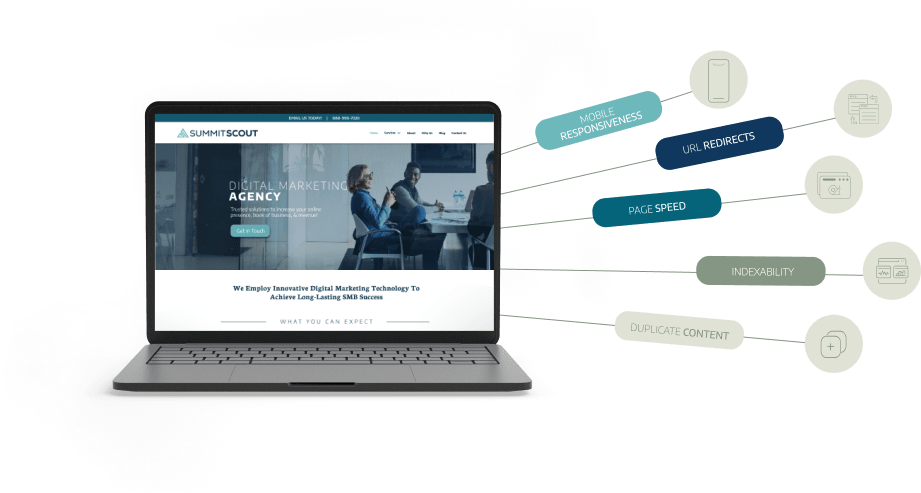
Is Technical SEO Difficult?
Technical SEO can be difficult depending on how advanced the necessary fixes are. If you’re a beginner in SEO, technical SEO can be more complex than for more experienced ones.
There are technical SEO elements that are simple to understand and resolve as well. For example, 301 redirects are a crucial technical SEO factor that is simple to plan for and implement.
Technical SEO Issues: 5 Common Problems
Nearly every website will encounter technical SEO issues. This section in the technical site audit guide maps out the most common problems that businesses typically encounter and how to get started on fixing them.
1. Unoptimized Meta Titles & Descriptions
Meta information (titles and descriptions) is the first thing search engines display in the search engine results page (SERP). It’s also the first thing a person will see after a Google search.
Your meta title and description are crucial in getting people to click on your organic search listing because it’s their first impression of the site. It must contain the page's primary keyword and enticing information that will encourage people to click on your listing over a competitor’s.
Some of the most common technical SEO issues with meta titles and descriptions include:
- Keyword is not optimized: The meta title is typically a ranking factor with search engines like Google. Place the primary keyword near the beginning of the meta title to increase your chances of ranking for the search term.
While meta descriptions are not a ranking factor, it’s a best practice for user experience to include the primary keyword in it as well.
- Meta titles and descriptions are too long or too short: Meta titles should be within 50-60 characters, while descriptions should be around 150 characters.
- Duplicate meta titles and descriptions: Reusing the same meta title and description on multiple pages is a major NO in SEO. It creates duplicate content and confuses search engines on what page should rank for the specific search term.
- Missing meta title and descriptions: Not writing a meta title and description for pages leaves it up to the search to decide what to display. Missing meta information can hurt your click-through rate (CTR).
Note: Manually setting your meta title and description does not guarantee that search engines will display it. Search engines can override your meta information with something they prefer if it doesn’t meet their standards.
2. XML Sitemap Issues
An XML sitemap provides search engines with a blueprint of your site. It helps search engine crawlers navigate to your most important pages more efficiently. Search engines like Google have confirmed that an optimized sitemap will positively impact your keyword rankings.
Missing sitemaps leave search engines to their own accord when crawling your website. It can create inefficiencies and may increase your crawl depth if your website is large. As a result, important web pages may not be crawled often or fully.
Additional XML sitemap issues include featuring URLs that are either broken, redirected, canonicalized, noindexed, or nofollowed. This can lead search engines to distrust your website and crawl it less frequently.
Best practices state that XML sitemaps should only have 200 status code URLs that you want search engines to crawl and index.
If you’re in need of a sitemap, you can create your own or hire a web developer to create one for you. One of the easier options is to use an XML sitemap-generating tool, such as a Yoast SEO plugin, to help automatically generate XML sitemaps for you.
3. Unresponsive Website
An unresponsive website is one of the most frustrating aspects for visitors navigating web pages. Web pages that are not loading properly, have skewed formatting, or have irregular text (copy) all fall under non-responding websites.
With more searchers using smartphones and mobile devices, a non-responsive website will also cause a poor mobile experience. According to a recent study, over 60% of search engine visits happen on a mobile device.
As mobile searches continually trend upward, Google has made this a core aspect of its algorithm. A non-mobile-friendly website will not rank as well as a mobile-friendly site that responds well.
Google wants to display the best results and websites to its users. To optimize your mobile experience and improve the responsiveness of your website, focus on the elements outlined below. Work with a web developer (if needed) to help you with more technical issues!
- Minify unused code to make your website speed more efficient.
- Improve the user experience and layout of your web pages.
- Optimize images, videos, and all other media to load faster.
- Make the font size at least 16 px for mobile devices.
- Test your website on all devices to ensure it loads and functions well across varying device sizes.
4. Slow Site Speed
Site speed is another important technical SEO factor that will immediately set expectations for website visitors. Recent data shows that nearly 70% of website users admit that site speeds affect their willingness to make purchase decisions on an ecommerce website.
Think about it: how often have you clicked out of a website or hit the back button on your smartphone when the web page wasn’t loading quickly?
In a progressing digital world, attention timeframes have decreased to the point where users want information immediately (within 4 seconds, to be exact).
Fast site speeds allow users to get information more quickly, providing a better user experience. Slow site speeds are often pushed to the side by many website owners, but it can hurt your visibility online since search engines will rank websites that load faster over those that load slowly. Some of the most common site speed issues include:
- Poor site structure and navigation.
- Unoptimized images (over 100 KB).
- Too many videos or ads on one page.
- Poor hosting services or not using a CDN (content delivery network) service.
- A lot of unused Javascript or CSS styling scripts.
The above list does not include all site speed issues, so your site may need further auditing to find other fixable elements. Consider working with a web developer to ensure optimization for your website's onsite and offsite elements.
5. Duplicate or "Thin" Content
Duplicate Content
With the amount of content published online daily, it’s not surprising that many sites get flagged for duplicate content. Search engines can easily find and flag duplicate content as they crawl through web pages.
If your website has duplicate content, it creates confusion with search engines in determining which page should rank for a specific keyword. It can also result in having none of the pages rank on SERPs. Duplicate content signals a poor user experience and potential malice or spam to search engines.
On the other hand, a website can also be flagged for duplicate content if it’s plagiarizing another online source without proper citations. Do not be afraid to reference authoritative sources to support your stance further and build engaging and trustworthy content, but remember to cite the source appropriately.
Thin Content
“Thin” content refers to content on a website that offers little to no value to the target audience or site visitor. Thin content could include pages that don’t have much or any copy (text), visual assets (like photos or videos), irrelevant information, or content that lacks detail or sufficient explanation.
Avoiding thin content helps improve your site's expertise and relevance, increasing the chance you rank for applicable keywords.
Do not write redundant content for the sake of using more words as a means to avoid “thin” content. The best practice is to answer all possible questions when creating content so you can sufficiently speak to the topic and offer genuine value to your readers.
15-Point Technical SEO Audit
Now that you’ve gained more knowledge about technical SEO, it’s time to dive into the technical SEO audit checklist. Below are 15 steps your business should follow when starting your technical SEO strategies.
1. Check Google Search Console Reports
Before you start improving your website’s technical performance, it’s important to check several reports in Google Search Console. Search Console is a free tool that provides numerous benefits and insight into a website’s performance.
For technical SEO, we recommend reviewing the following reports and tools:
- Page Indexing
- URL Inspection Tool
Page Indexing Report
The Page Indexing report shows the Google indexing status of all URLs that Google knows about in your property. As shown below, the report is categorized into two status levels: Not Indexed and Indexed.
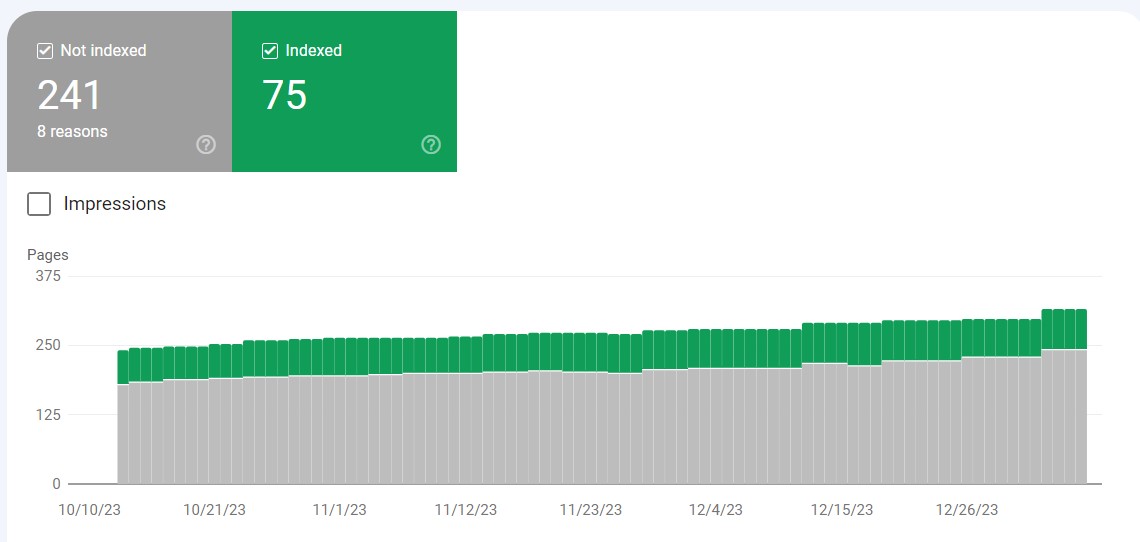
Specific reports providing a deeper analysis of the website’s page indexing are displayed below. Some of these reports can be complex and require advanced knowledge of SEO.
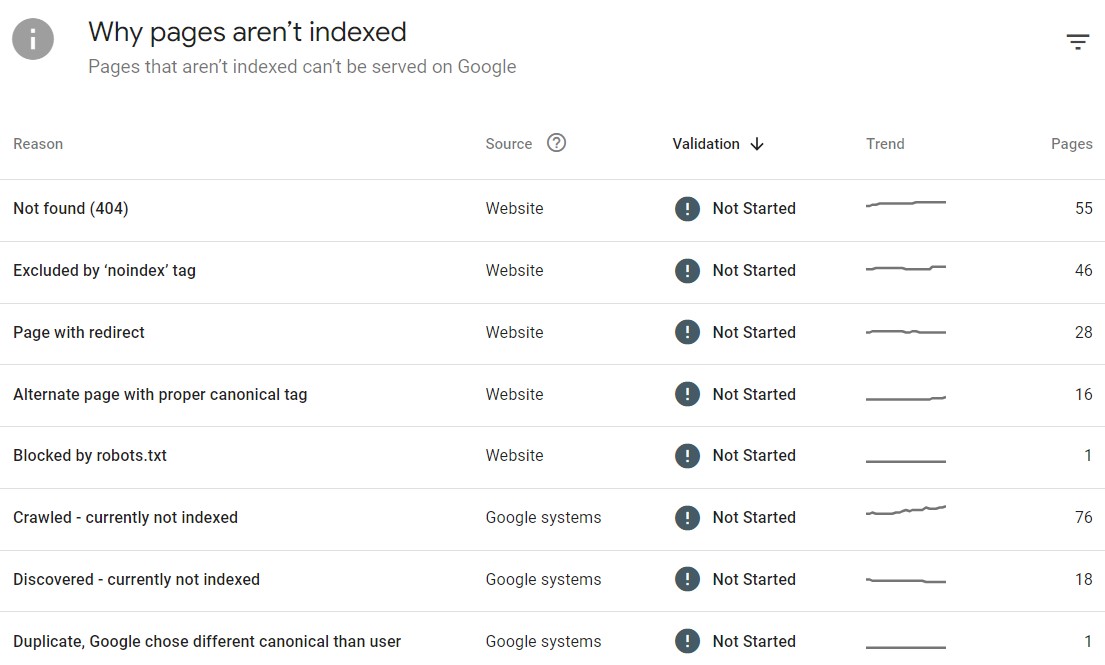
These reports do not always signal technical SEO issues. Sometimes, certain pages are intentionally set to be ‘noindex,’ so Google won’t rank them in their SERP. Other times, pages were deliberately removed and redirected, which will inevitably appear in these reports.
However, Google can have trouble finding and indexing pages that you actually want to rank in Google SERPs; this report can help you identify that. From there, you will need to dig deeper into what’s causing that issue and possibly work with a developer to resolve this if you can’t do so alone.
URL Inspection Tool
Last but not least, the URL Inspection Tool is a great asset for website owners to inspect the indexing status of a specific URL immediately. At the top of the Google Search Console dashboard, there is a search bar where you can input the URL you want to inspect.

The result page shows whether the URL is indexed, mobile-friendly, and other enhancements featured on that page, like schema markup. You can also Test the Live URL to see how Google sees your page now, not just from a snapshot in time.
Pro Tip: If you have created a new page or updated content on your website, you can submit the page URL in the URL Inspection Tool to request indexing from Google. Click the ‘Request Indexing’ text link in the first white square.
This alerts Google of a page update and to prioritize it in the next crawl. It’s not a guarantee that Google will immediately crawl and index your page, but it’s a good way to alert them of a change and hopefully speed up the process.
2. Run a Technical Site Audit
Running a technical site audit for your website is very important to your technical SEO strategy. A site audit helps point out errors and issues within your site to help improve the health, technicality, and user experience of your site.
If you’re new to this, you can start with a free SEO audit. A free audit will help get you started by giving you clear action items on what to fix so you can start gaining more website traffic.
Along with learning how to conduct an audit, and if you have the means to purchase, there are additional SEO tools you will need that will help you be more effective. Utilizing tools such as Screaming Frog, Ahrefs, or Semrush will help you identify more areas of your site that need improvement, as well as information on the site structure and current SEO setup.
If you want these tools' full capabilities, you must sign up for a monthly or annual subscription. However, Screaming Frog and Ahrefs do provide some free tools and features that small businesses can take advantage of!
Screaming Frog allows you to crawl up to 500 URLs for free, which is perfect for most small business websites, and the report is very insightful.
3. Check the Robots.txt File
Sometimes, there are areas of your website that you might not want search engines to crawl or index. Lucky for you, there’s a way to add a file into the HTML of your site for search engines to recognize where you don’t want them crawling.
This file is called a robots.txt file, and it tells search engines which pages to access and crawl (and which to not).

It’s placed in the root directory of your site. While you’re able to add this file, there is still the possibility of pages that are blocked from being crawled. For more confidential and sensitive pages, use a more secure method.
4. Secure Your Website
Yes, website security is a common technical SEO issue and a ranking factor. At this point, all websites should show “HTTPS” within the URL rather than “HTTP.” If your site hasn’t been updated, fixing it should be a top priority!
An “HTTP” (non-secure URL) can hurt your rankings. A secure website is accomplished by purchasing and installing an SSL (Secure Sockets Layer) certificate. In simple terms, an SSL certificate ensures that data and information passing through the website are encrypted and protected.
A site with a fully installed and working SSL certificate will display “HTTPS” within the URL instead of “HTTP.” Here are the four simple steps to ensure your website is fully secure:
- Host the website and domain on a dedicated IP address.
- Purchase an SSL certificate from a trusted provider.
- Request and Install the SSL certificate (with help from the provider if necessary).
- Update and test the website to ensure the SSL certificate works.
Keep in mind that rankings will initially drop during an SSL migration. Working within an organic SEO company can help mitigate significant losses and help recoup traffic and rankings quickly!
5. Create and Submit an XML Sitemap
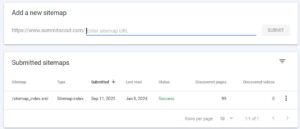 Web developers use sitemaps to inform search engines which URLs to index as they crawl a site. XML sitemap serves as a blueprint for a website, helping search engines better understand how to read and navigate through the site. They also help search engines understand which pages hold the most authority and how the pages connect with one another.
Web developers use sitemaps to inform search engines which URLs to index as they crawl a site. XML sitemap serves as a blueprint for a website, helping search engines better understand how to read and navigate through the site. They also help search engines understand which pages hold the most authority and how the pages connect with one another.
Follow the steps of creating and submitting an XML Sitemap:
1. Depending on your website, create automatically or manually.
a. Automatically create using your CMS platform (WordPress, Wix, etc.)
b. Use 3rd party sitemap creator: xml-sitemaps.com
c. Manually create by following these steps outlined by Google Search Central
2. Upload and submit the sitemap to the site and Google Search Console be following these steps:
a. Sign into Google Search Console
b.Within the main navigation menu, under “Index” click on “Sitemaps”
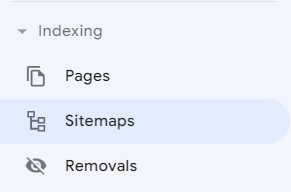
c. Submit your sitemap by entering the sitemap’s URL into the “Add a new sitemap” field
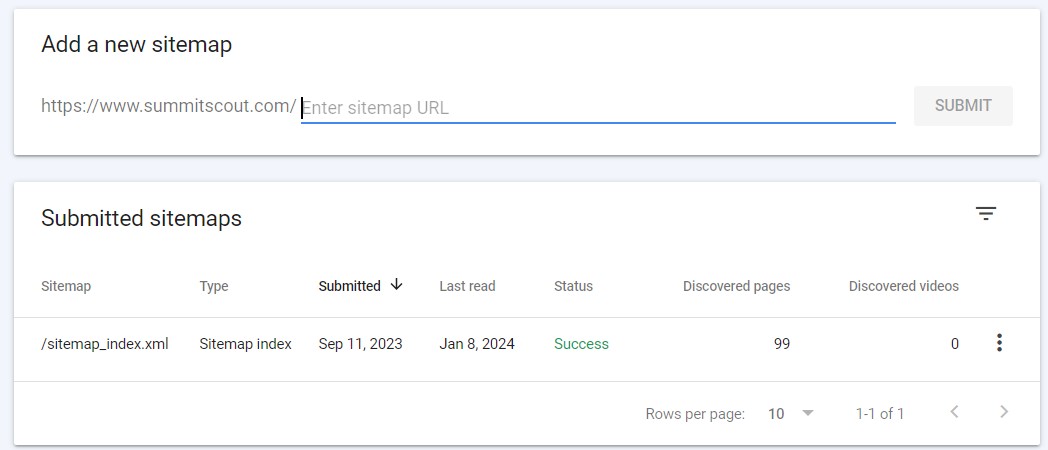
d. Click “SUBMIT”
Keep in mind that larger websites will submit multiple sitemaps to keep things organized. Once you have followed the steps outlined above, you should see information and data relating to the submitted sitemap.
Under status, check back for when it says “Success” and shows a date under “Last read.” This means Google successfully crawled the sitemap!
You can also test the sitemap by searching “/sitemap_index.xml” or “sitemap.xml” after the home URL. (ex: google.com/sitemap.xml)
To follow technical SEO best practices, use a flat, organized site structure.
An organized site structure similar to the example shown below will help search engines and users explore your website!
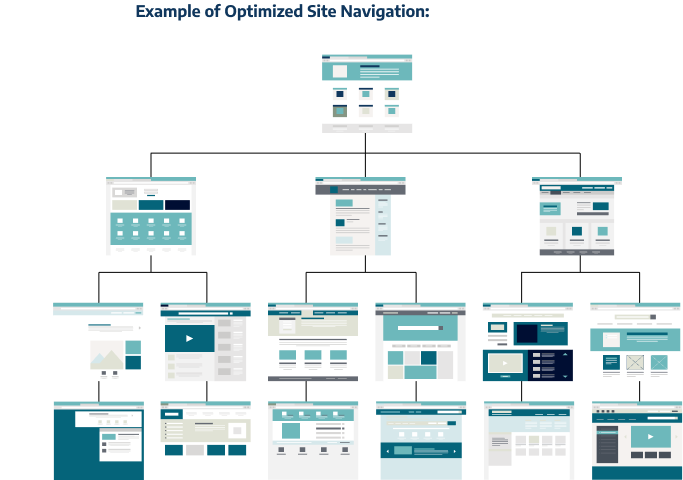
More benefits of an organized site structure include:
- Creates a seamless user experience so site visitors can easily find pages and navigate from one page to the next.
- Assist search engines in understanding your site hierarchy and which pages are the most (or least) authoritative.
- Helps search engines understand how the pages are connected through links and the navigation structure.
Avoid Orphan Pages
Orphan pages are pages on a site that don’t link or connect with any other page on the website. When users (or search engines) can’t find a way to link to get back to other pages or the main navigation menu, it can negatively impact your site's crawlability and usability.
Search engines take this as a sign that the orphan page is not valuable, which can make it extremely difficult to rank for its assigned keywords. Whenever you create new pages, it’s best to make sure they link back to the main navigation menu.
Use Primary Navigation Menus
For websites and search engines, the most authority is allocated to the pages that are in the main (Primary) navigation, trickling down to the subpages within. This is why it’s best practice to have a mega menu with Primary pages.
Unlike a secondary or tertiary drop-down menu, a mega menu spreads out the authority more evenly. It’s easier to lose authority and value with these types of navigation structures.
7. Feature Breadcrumbs
Breadcrumbs are website navigational links that allow users to track where they are, where they’re going on a website, and how far they are from the homepage.
Breadcrumbs are used to create a better user experience for users and help them find the information they are looking for on a website. You can usually find them at the top of a website or just under the navigation bar.
This step isn’t always necessary for a technical SEO audit, but it is highly recommended as a best practice to implement. It helps enhance and improve websites by keeping the site organized, helping site visitors know where they are and where they’re going, and overall improving user experience as a whole.
They are essential to your technical SEO strategy because they directly impact SEO. Google displays breadcrumbs in the search results and uses breadcrumbs to categorize information in the search results.
8. Use Consistent and Clean URLs
When putting together URL structures, having a simple and clean URL can be the winning ticket for your website and SEO to succeed. It’s vital to have clean, uniform, consistent URL structures and folder pathways that avoid featuring random numbers, letters, and symbols.
Random letters, numbers, and symbols in URL structures create a poor user experience and risk confusing site visitors. Additionally, avoid using anything that will make your content outdated in the URL, such as a date.
Technical SEO best practices dictate that URLs should remain consistent and clean and not change depending on which category they fall under or the applied filter. The reason for this is to help avoid creating duplicate content unnecessarily.
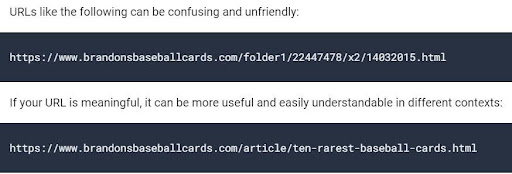
Keeping URL structures and folder pathways is extremely important, especially for ecommerce websites. Especially those that feature products that fall into multiple categories or have filters that can be applied (different colors, sizes, etc.).
Ecommerce SEO best practices also dictate that it’s important not to change the category or filter once applied. Doing so can create structural and redirection issues in the future.
A clean URL needs to follow certain technical SEO best practices to succeed over time. Here is a list of a few for you to follow:
- Do not feature random symbols, numbers, and letters that are unnecessary to include. When you include any of these elements (that can be taken out of the URL structure) into the URL structure, you will have a harder time taking them out in the future.
For example, let's say you have a blog article that needs to be repurposed. It’s titled “5 Link Building Strategies for Your SMB to Implement”. The URL you have is listed as “5-link-building-strategies-for-your-smb-to-implement”. When you go back to repurpose the content, you are limited to keeping the number of strategies at 5, even if you have more to add.
You can fix the URL, but you will have to add redirects to link back to the original article. This can result in losing value from the original article and backlinks.
- URLs should be intuitive of what the page will be about before it loads. You want your URL to describe what the users are clicking on and that it meets their expectations. You wouldn’t want to mislead site visitors when the URL structure lies on where it’s going. Keep your URL structure descriptive but to the point to help give users an idea of what they’re clicking on.
- Incorporate a keyword into the URL if possible. With any SEO strategy, there should always be opportunities for you to look at where you can implement keywords effectively. Adding them to the URL is one of those places!
If it’s included in the heading and makes sense to go in the URL as well, then go for it! Doing so can help the site’s performance as well, ranking higher in SERPs. However, if adding it to the URL structure doesn't make sense, it’s better to leave it out than force it in.
9. Use Canonical Tags Properly
This can become an advanced technical SEO practice, but each page should have a self-referencing canonical tag at its most basic level.
A self-referencing canonical tag serves as a safeguard for a webpage and tells search engines that this is the main URL and should be the one to be indexed on a search engine results page (SERP), not a parameter version.
A parameter version of a URL includes certain measures or conditions, like a filter. You have most likely seen one when shopping online—it’s a URL with a ‘?’ in it and features various measures following it.
We will use Nordstrom as an example below to better explain what a self-referencing canonical tag and a parameter URL are.
The clean URL for the Women’s Shoes category is:
https://www.nordstrom.com/browse/women/shoes
A self-referencing canonical tag for that page would be the same as the clean URL: https://www.nordstrom.com/browse/women/shoes
However, the URL changes when filters are applied (in this case, we are filtering out the results to show blue women’s shoes):
https://www.nordstrom.com/browse/women/shoes?offset=9&filterByColor=blue
Notice how there is a ? after ‘shoes’ with the filter applied to show only blue shoes.
If there is no self-referencing canonical tag set for the Women’s Shoes category page, search engines will crawl and index any parameter URLs in addition to the main category.
The problem with this is that the information is the same, and it can create duplicate content, making it more difficult to rank for a particular keyword, and it does not follow Google’s Quality Raters Guidelines.
10. Fix Broken Pages and Images
Pages or photos that lead to 404 (page not found) errors will negatively impact your user experience and SEO efforts. Luckily, the solution is quite simple – use a 301 redirect.
Redirects help developers and marketers fix broken pages and consolidate authority. Use 301 redirects to redirect broken pages permanently. Use 302 or 307 redirects to temporarily redirect broken pages, especially if the page or photo will be fixed quickly.
If a broken page never had any backlinks or traffic when it was live, transferring it to another link is useless because there’s no value to moving. Use a 410 redirect to signal a permanently removed page in this case.
Follow these additional technical SEO best practices when managing web pages:
- Create evergreen URLs. Avoid using dates, numbers, months, etc., in URLs because these factors can outdate the content.
- Be methodical and intentional with the web pages you create or remove. When creating a page, ensure it fits within your site’s overall strategy and structure. Plan out your site’s navigation and pages in advance to ensure it stays organized.
- Keep your ecommerce site up-to-date at all times. If a product is out of stock (temporarily or permanently), make sure to create a good experience for users as this happens.
11. Fix Broken Internal and External Links
External links are when a website links out to a third-party site. When an external link links to an authoritative website, it helps build a site’s trust and expertise with search engines.
Internal links are when a website links to other pages within the same website. They also help influence keyword rankings, which helps keep people on websites for longer and improves user experience.
Broken internal and external links can hurt your technical SEO performance because they diminish the user experience and disrupt the authority and trust flow that such links can offer to your website and site visitors.
It’s a technical SEO audit best practice to analyze internal and external links for broken URLs. Technical site audit tools make this much easier and faster than inspecting each webpage manually.
How to Fix a Broken Internal Link
To fix a broken internal link (a 404 error page), you only need to create a 301 redirect (permanent redirect) that sends website visitors to the next most valuable page. If possible, try to make it relevant to what the broken page used to be.
For example, if a product has been discontinued permanently, the redirect should be to a product similar to the discontinued product or the next best option.
If such an alternative doesn’t exist, redirecting the broken page to the home page or the overarching category page is also acceptable!
How to Fix a Broken External Link
External links point to third-party websites. Unless you can access the backend of that third-party website, you will not be able to add a redirect. You can find where that broken external link is referenced within your website and replace it with an updated source.
While 301 redirects are helpful for SEO, redirect chains and loops can be created unintentionally if those internal and external links are not regularly monitored and updated.
What is a Redirect Chain?
A redirect chain occurs when there is more than one redirect between the original internal link and the final destination.

What is a Redirect Loop?
Redirect loops are when there are two or more pages that redirect to one another, never sending the site visitor to a final destination. Instead, the site visitor is caught in a redirect loop between the two redirecting pages.
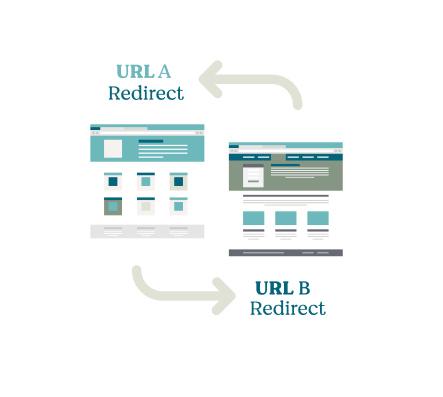
Why are Redirect Loops and Chains Harmful?
Redirect loops and chains can hurt your site speed and user experience performance, so it is still necessary to update the internal and external links on your website directly to point to the live webpage instead of relying on a redirect.
12. Make Your Website Load Faster
Along with other technical SEO factors, site speeds can directly impact your rankings on search engines. Google Developers have said when real users visit your site and experience slow speeds, they are less likely to take action or make a purchase decision.
In turn, speed is a necessary landing page factor for both Google search and ads.
Think about a time when you have visited a site and a page doesn’t load or loads very slowly – frustrating, right? It makes sense that Google would include site speed as a ranking factor. Here are a few ways to reduce site speed load times as a small business owner:
- Make images smaller without compromising on the quality of the image. It can be time-consuming, but resizing the images to be smaller than 100KB is best. Use a smushing (compressing) plugin if possible. WP Smush works great for WordPress sites.
- Clean up and remove unused plugins from your site’s CMS. Remember, you can always re-download plugins again if needed in the future. Third-party scripts take up a lot of space – which can significantly slow down the speed of your website.
- Remove unused images or media assets that take up a lot of space. Some photos and videos could exist on your site with no purpose. Often, website owners forget what images or media they have uploaded to their CMS platforms. This still takes up a lot of space, so it’s important to do maintenance on this at least once a year.
Use these free resources to test individual page URLs for site speed performance:
13. Avoid Thin Content
Thin content will not benefit your SEO efforts in any way. Additionally, for the sake of not being “thin,” redundant and overly stuffed content won’t help either. Content with a lot of “fluff” or not useful information can also be considered thin content.
Create high-quality content that engages the user and provides them with useful information. Website copy should be informative and valuable, and keywords should be used strategically while avoiding keyword stuffing. Follow these guidelines when creating content:
- Create new, unique content for each page on your site that sufficiently answers every possible question a site visitor may have (we strongly recommend reviewing Google’s blog on what you need to know about core updates and answering questions properly in website content).
- Include engaging photos, graphics, and videos to draw in users.
- Use meta tags, heading tags, and subtitles to improve readability.
- Incorporate internal links into the content to keep people on the website for longer and positively influence keyword rankings.
- Make sure the word count per page is consistent and sufficient. Anywhere from 1500-3000 words per page is a good starting point.
- Add jump links into the content to help guide people to the sections that answer their questions.
Following the best content marketing practices will improve your technical SEO so you can start achieving higher rankings. Check out these SEO content auditing tools to help you monitor and fix any thin content issues:
14. Avoid Duplicate Content
As mentioned earlier in the article, duplicate content will hurt your SEO. Search engines want to display the best results to their users. Plagiarized or copied content automatically shows search engines a site is questionable and potentially untrustworthy.
If you own a website, create unique content for each page to follow technical SEO best practices. Most of the time, this will avoid any issues of duplicate content. If you own multiple sites, keep content across those sites unique and original.
Repeated content across various sites (even if you own them all) is still considered duplicate content. Check out these free tools that will scan your site(s) for duplicate content across the web:
- Siteliner
- Copyscape
To follow technical SEO best practices, create a content strategy and keep tabs on what kind of content you already have published. Build out a content index where you can track all of the content on your site in one form or document.
Producing content around different ideas and topics within your industry will also keep your content unique. An optimized content strategy is the simplest and most effective way to avoid duplicate content.
Keyword Mapping
Map out keywords for specific pages instead of using them all over the website without a clear strategy. In addition to mapping out keywords, map out the intent of each page.
Determining intent includes determining what searchers want to see for various search terms. Create pages that will match and answer their search on your website. Do not create numerous pages explaining the same exact thing. It will create unnecessary competition within your website and can negatively impact SERP rankings.
Improper use of canonical tags will also create duplicate content issues. When search engines see URLs connected through duplicate content, they flag the associated URLs, and keyword rankings can drop. Ultimately, duplicate content can result in a web page not ranking for your target keyword – avoid it in all situations.
15. Use Internal Links Strategically
Internal linking means you’re adding direct links from one part of your website to another area of your website. An internal linking strategy that makes sense, is organized, and targets the right intent is a best practice.
There are a variety of reasons why you should be using internal links strategically, such as:
- Helps keyword rankings.
- Helps distribute authority between pages.
- Helps keep people on your site for longer.
- Improves user experience.
- Helps search engines understand which pages you want to drive authority to and which are the most important.
When there’s a page that doesn’t have any internal links in them, they are considered an orphan page. This means they will not rank or receive any authority, value, or attention from search engines. If there are pages you want to be recognized and noticed by search engines, be sure to include internal links within them along with effective anchor texts.
Having effective anchor texts with keywords implemented into them will help make connecting your content through internal linking much easier for customers to follow.
Technical SEO Audit FAQ
Technical SEO is important because it addresses critical technical site audit issues present on a website. It identifies opportunities to improve website structure, functionality, site speed, navigation, and much more.
Technical SEO improvements help search engines better navigate and understand your website, resulting in higher rankings.
